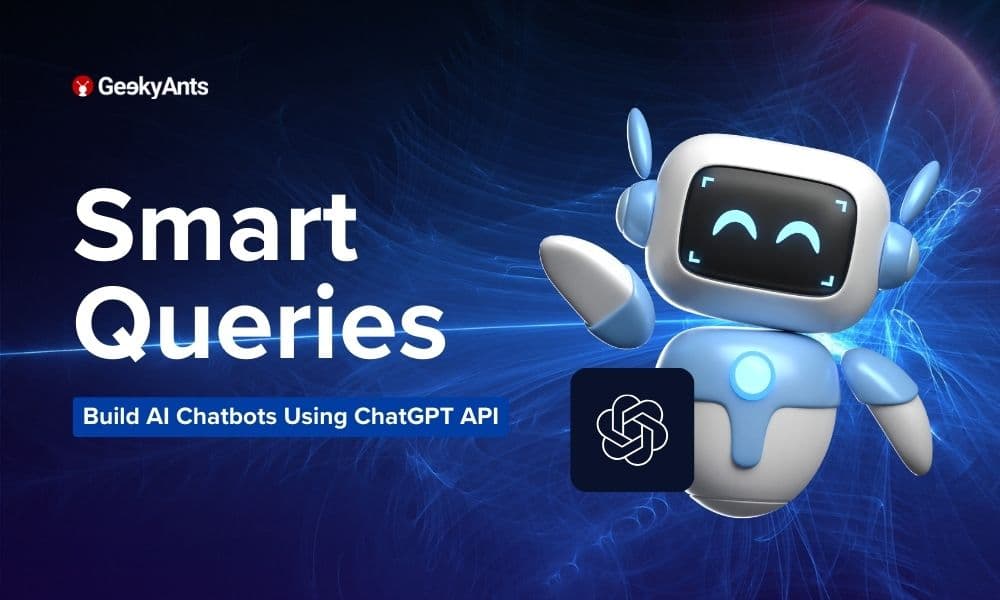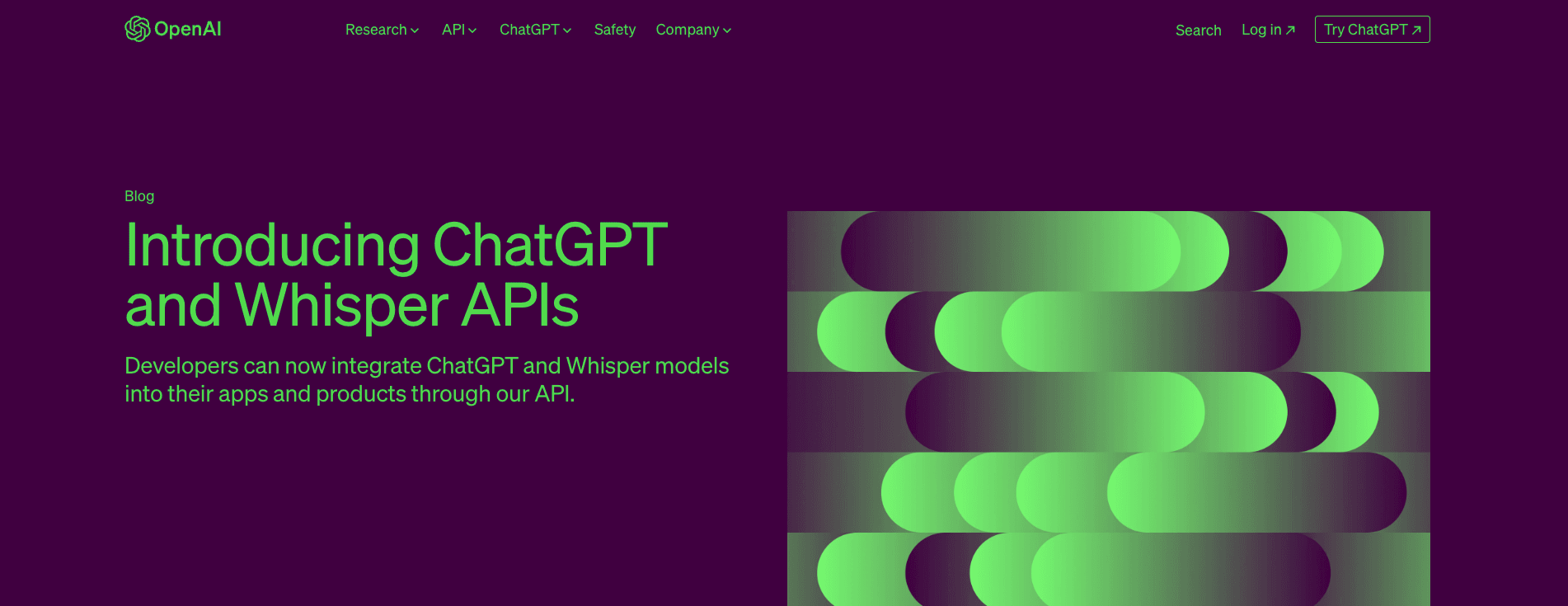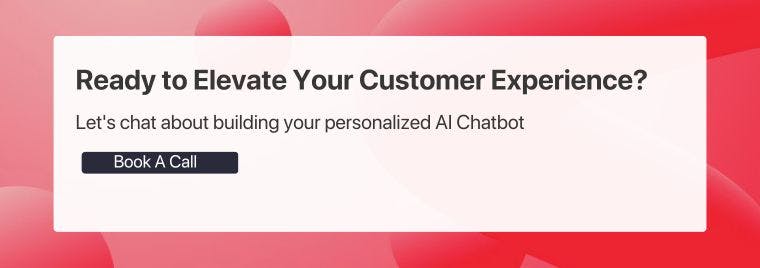Table of Contents
How To Build AI Chatbots Using ChatGPT API - With Live Demo Video
Author

Subject Matter Expert

Date

Book a call
Prompt communication is one of the keys to running a successful business. In recent times, brands have radically transformed the ways in which they choose to communicate with their customers. Customer queries today are being answered by live chats, through social media, online forums or communities, and, most notably, AI-powered chatbots. Chatbots are AI software that can converse naturally with customers through text or audio, freeing up precious time for resources to handle more complex tasks.
The size of the chatbot market is forecast to reach around 1.25 billion U.S. dollars in 2025, a great increase from the market size in 2016, which stood at 190.8 million U.S. dollars. — Statista
In this article, we walk you through the steps to creating interactive and dynamic chatbots that can engage in natural language conversations with users using ChatGPT API.
Understanding the Basics of ChatGPT API

OpenAI has introduced the ChatGPT API, which is designed specifically for building conversational agents and chatbots. It allows developers to integrate ChatGPT into their applications, enabling dynamic and interactive conversations with users. ChatGPT is based on the GPT model but fine-tuned specifically for conversational AI applications.
It can handle long conversations with up to 4096 and 8000 tokens for GPT-3 and GPT-4, respectively, facilitating in-depth interactions between users and chatbots in mobile apps. With the ChatGPT API, developers can integrate interactive chatbots, virtual assistants, or customer support agents into their mobile apps. Users can engage in meaningful conversations with these AI-powered entities, receiving personalized and contextual assistance within the app.
Some OpenAI APIs to Know:
- OpenAI GPT-3 and GPT-4 APIs: The GPT-3 and GPT-4 APIs enable you to generate human-like text, answer questions, summarize text, and perform other tasks.
- OpenAI Codex API: The Codex API enables you to generate code based on natural language instructions.
- OpenAI DALL-E API: The DALL-E API allows you to generate images from textual descriptions.
- OpenAI CLIP API: The CLIP API allows you to classify images based on textual descriptions and vice versa.
- OpenAI Language API: The Language API enables you to perform various natural language processing tasks, such as text classification, entity recognition, and sentiment analysis.
- OpenAI Translation API: The Translation API allows you to translate text into different languages.
Creating an AI chatbot using the ChatGPT API can enhance your applications with conversational AI capabilities. The next section outlines a step-by-step approach to integrating the powerful functionalities of ChatGPT into your projects.
Build AI Chatbots with ChatGPT API (A Step-by-Step Guide)
Before we start, let us take a look at the steps involved:
Step 1: Understand the Basics
Step 2: Define Your Chatbot's Purpose
Step 3: Setup Your Development Environment
Step 4: Obtain OpenAI API Key
Step 5: Install Necessary Libraries
Step 6: Create Your Chatbot Script
Step 7: Test and Iterate
Step 8: Integrate With Your Application
Step 9: Deployment and Monitoring
Step 1: Understand the Basics
Before diving into development, familiarize yourself with the fundamentals of AI, chatbots, and the ChatGPT model. ChatGPT, developed by OpenAI, is a variant of the GPT (Generative Pre-trained Transformer) model tailored for generating human-like responses in a conversational context. Knowing the capabilities and limitations of ChatGPT will help you design a better chatbot experience.
Step 2: Define Your Chatbot's Purpose
Determine what you want your chatbot to do. ChatGPT can be adapted for various uses, such as customer service, education, entertainment, or personal assistants. Defining the purpose will guide the customization and integration process.
Step 3: Setup Your Development Environment
Ensure you have a suitable development environment. You will need:
- Programming knowledge (Python is commonly used for interacting with the ChatGPT API).
- An IDE or text editor.
- Access to the ChatGPT API, which requires an OpenAI API key.
Step 4: Obtain OpenAI API Key
Sign up for an OpenAI account and access the API key. The API key is essential for authenticating and interacting with the ChatGPT API. Handle your API key securely to prevent unauthorized access.
Step 5: Install Necessary Libraries
Install the OpenAI Python library to interact with the ChatGPT API easily. Use pip or any other package manager to install it:
Step 6: Create Your Chatbot Script
Start coding your chatbot. Here's a simple Python script to interact with ChatGPT:
Replace 'your-api-key-here' with your actual OpenAI API key. Modify the prompt and max_tokens as needed to suit your chatbot's purpose.
Step 7: Test and Iterate
After creating your initial script, test it thoroughly. Experiment with different prompts and settings to refine the chatbot's responses. Pay attention to the chatbot's accuracy, responsiveness, and ability to handle unexpected queries.
After creating your initial script, it is crucial to test it thoroughly. For example, if your chatbot's purpose is to provide customer support for an online electronics store, you should prepare a variety of prompts related to common customer inquiries, such as:
- "How can I track my order?"
- "What is your return policy for a laptop?"
- "Do you have the latest model of XYZ smartphone in stock?"
Experiment with these prompts and adjust the settings to refine the chatbot's responses. Observe how well the chatbot understands the context, provides accurate information, and guides the user to the next steps. You might also introduce unexpected queries to see how the chatbot handles them, such as "Can you tell me a joke?" or "What's the weather like?" This can help you gauge the chatbot's versatility and ensure it remains helpful without veering off-topic.
Additionally, you may want to simulate different customer temperaments by altering the tone of the inquiries from polite to frustrated to ensure your chatbot maintains a consistent and appropriate response style.
Understanding the Concept of Prompt Engineering
Prompt engineering can significantly enhance the performance of a chatbot by:
- Increasing Accuracy: By clearly specifying the context and the expected response format, the chatbot can more accurately address the user's intent.
- Improving Consistency: Structured prompts ensure that the chatbot's responses are consistent, both in tone and structure, which is essential for user experience.
- Enhancing User Satisfaction: User satisfaction increases when a chatbot reliably provides information in a useful format.
Example: Electronics Store Customer Support Chatbot
Let's say we're building a chatbot for an electronics store that handles queries about product specifications and availability. We want the chatbot to accept queries about any product and return information in a specific format: "Product Name - Availability Status - Main Features."
Step 1: Define System Prompts
We define system prompts that guide the chatbot on how to structure its responses. For example:
- When asked about a product's availability: "Respond with the product name, followed by its availability status, and then list its three main features."
- For product recommendations: "Suggest three products based on the user's query, including the product name, a brief description, and the price."
Step 2: Example Code with Prompt Engineering
Here is a Python code snippet that uses prompt engineering with the OpenAI API to handle a query about a smartphone's availability:
This script sends a structured prompt to the ChatGPT API, directing it to provide a response in the desired format. The system_prompt variable is crafted to include instructions for the chatbot, integrating both the user's query and the expected response format.
Considerations for Prompt Engineering
- Clarity and Specificity: The clearer and more specific your prompts, the better the chatbot's responses will be. Tailor your prompts to guide the AI towards the type of answer you're looking for.
- Experimentation: Different formulations of prompts can lead to different outcomes. Experiment with variations to find the most effective prompts for your use case.
- Feedback Loop: Use real-world interactions as feedback to continually refine your prompts. This iterative process will improve the chatbot's performance over time.
Prompt engineering is both an art and a science, requiring iterative testing and refinement to perfect. By applying these concepts, your chatbot can more effectively serve users, providing them with information in a consistent and helpful format.
Step 8: Integrate With Your Application
Once satisfied with the chatbot's performance, the next step is to integrate it into your application. This process can involve various tasks, such as developing a user-friendly frontend interface, setting up webhooks for dynamic interactions, or creating APIs for seamless integration across different platforms, including web and mobile applications.
Creating a Flask API for Backend Integration
To exemplify backend integration, we will develop a simple Flask API. This API will act as an intermediary between your application and the ChatGPT model, facilitating the sending of queries and receiving of responses without a direct user interface.
- Install Flask: Ensure Flask is installed in your development environment. Use pip for installation if Flask is not already installed:
- Setup Your Flask Application: Begin by creating a new Python file for your Flask app. This app will specifically include an API endpoint for processing chatbot queries.
- Example Flask API Code: Let's adapt the Flask app to provide an API endpoint. This endpoint will accept JSON payloads containing user queries and return the chatbot's responses in JSON format.
In this modified code:
- The Flask app defines a
/chatendpoint that exclusively handles POST requests. - It expects a JSON payload with a
user_queryfield. - The chatbot's response is returned in JSON format, making it easily consumable by any frontend or service that calls this API.
- Testing Your API: To test the API, you can use tools like Postman or a simple
curlcommand from the terminal. Here's an examplecurlrequest:
This command sends a POST request to the /chat endpoint with a JSON payload containing the user query. The response will be the chatbot's answer to the query in JSON format.
This approach demonstrates how to integrate the ChatGPT model into your application's backend using a Flask API. By providing a dedicated endpoint for processing queries, this setup allows for flexible integration with various frontends, offering a seamless way to enhance your application with AI-powered conversational capabilities.
The demo video below showcases a Flask app endpoint in action, using Postman to interact with the OpenAI API for real-time question-answering.
Step 9: Deployment and Monitoring
Deploy your chatbot and monitor its performance. Collect feedback from users to identify areas for improvement. Regularly update the chatbot to refine its responses, expand its capabilities, and incorporate the latest advancements in AI from OpenAI.
The final demo video shows us the frontend interaction with LLM-based chatbot, via API calls:
Benefits of Using ChatGPT API for Building AI Chatbots
At the risk of sounding cliche, ChatGPT really is a game-changer when it comes to building AI chatbots. It is great at understanding and chatting in human language. No matter what the user throws at it, ChatGPT can handle it and respond in a way that feels human. Plus, it is pretty flexible - developers can tweak it to suit whatever they are working on, making the chatbot's responses fit perfectly with the task.
- ChatGPT can keep up with long chats without getting lost, so its responses always make sense in the conversation. This means chatbots can give personalized and detailed answers.
- By using ChatGPT, chatbots can chat more naturally and effectively, making them better at helping users out.
- Whether you dream up advanced chatbots, want to automate customer support, or want to generate creative content, the ChatGPT API covers you.
- OpenAI has a range of models to choose from, depending on what you need and your willingness to spend. You can pick what works best for your project, from the top-of-the-line GPT-4 to the more budget-friendly GPT-3.5 versions.
So, if you are excited to start playing around with this cool tech, this guide is a great place to start!
Enhance Customer Service: Build AI Chatbots with GeekyAnts
With a robust portfolio of 500+ projects, GeekyAnts is well-known in the mobile and web app development space, executing end-to-end solutions with our signature touch.
Our Key AI Offerings
- Enhanced Customer Service: Employ our 24/7 AI-powered chatbots for immediate customer assistance, ensuring unparalleled service quality.
- Product Growth: Elevate your products with our AI-infused solutions, driving innovation, user-centricity, and market relevance.
- Accelerated Development: Experience streamlined processes, from ideation to delivery, using AI for faster, more efficient project completion.
- Decision Making: We leverage AI-driven data analysis for actionable insights, enabling informed and strategic business decisions.
- Operational Efficiency: We help identify and rectify inefficiencies with AI, significantly reducing costs and enhancing overall performance.
Our Work Highlights
- HR Bot: Our AI-driven HR bot is designed to simplify tasks, automate workflows, and enhance employee satisfaction. It can handle a variety of HR functions, such as answering FAQs, managing leave requests, and providing updates on company policies. It's designed to boost productivity and streamline HR operations.
- Database Generator: A powerful tool that can manage and organize your data more effectively. It allows you to set up and manage databases with intuitive commands, saving you time and reducing the risk of errors. The automated setup process makes it easy to get your database up and running quickly.
- FitnessGPT: FitnessGPT is a personalized fitness guide powered by AI. It provides tailored exercise routines and nutritional insights based on user's goals and preferences. Whether you're a beginner trying to get fit or an athlete looking to optimize your training, FitnessGPT can help you achieve your fitness goals.
GeekyAnts is committed to integrating cutting-edge AI solutions into businesses, transforming operations, and driving growth. We invite you to leverage our expertise and innovative AI offerings to accelerate your business transformation journey.
Dive deep into our research and insights. In our articles and blogs, we explore topics on design, how it relates to development, and impact of various trends to businesses.



